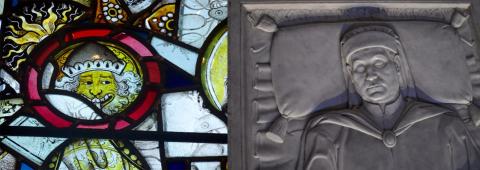Chaucer and Boccaccio
Boccaccio and Chaucer are two of the great western authors of the Middle Ages, with exceptional geographical range, social inclusiveness, and female identification. Chaucer took more from Boccaccio than from any other writer but never acknowledged him by name: why was that? Perhaps Chaucer and Boccaccio are just too much alike: disciples of Dante, admirers of Petrarch, sons of the international mercantile class attempting to come to terms with French-based, courtly society.
Chaucer twice travelled to Italy in the 1370s, visiting Genoa, Florence, and Milan. Briefed to borrow Italian support for England's endless war with France, he immersed himself in Italian (which he knew exceptionally well) and its literatures. He returned home with manuscripts of at least two Boccaccian texts: the Filostrato (reworked into Troilus & Criseyde, which then spawned Shakespeare's Troilus and Cressida), and the Teseida (Knight's Tale, then Shakespeare's Two Noble Kinsmen). Having grasped the greatness of Italian literary tradition, and the feebleness of English, in his House of Fame, Chaucer completed Troilus and turned to the framed storytelling of his Canterbury Tales. Clearly inspired by the Decameron, Chaucer became an encyclopaedist of literary genres, fitting in tales of great men (from Boccaccio's De casibus virorum illustrium) and great women (from Boccaccio's De mulieribus claris). And, like Boccaccio, he explored the widest range of contemporary issues, including Judaism and Islam, and their dealings with Christianity; rural poverty and peasant cunning; urban trickery and the ruin of great cities; sexual mythologies (why can women talk their way out of anything?); exoticism and romance; alchemy and sodomy; saintliness and superstition; relic worship and relic forgery; Crusading and the follies of war.
Some talented speakers of both Italian and Middle English will take this class, ditto Latin and French, so we'll be well served for studying, or making reference to, the original languages. But not everybody can read everything, so we'll pool resources. One work not much taught that we can consider, via parallel text, is the Elegia di madonna Fiammetta, which sees Boccaccio writing as a woman abandoned by her lover. Which raises the question: why do Boccaccio and Chaucer take so much time, and evidently pleasure, putting themselves into the bodies of (imagining themselves as) women? Answers to this question might help explain why so many contemporary women poets (often minority women) have taken to Chaucer: Sylvia Plath, Lavinia Greenlaw, Marilyn Nelson, Caroline Bergvall, Patience Agbabi, Jean Binta Breeze, Pattie McCarthy. Do women artists in Italy find comparable inspiration from Boccaccio?
Chaucer and Boccaccio remained paired in English imagining into the English Renaissance, where (ironically) Boccaccio was found more acceptable: whereas Chaucerian poetry seemingly changes genre with each new tale, Boccaccio's Decameron suggests greater generic stability through its one hundred novelle. Boccaccio thus becomes an acceptable model for English Renaissance style, remaining hugely influential (as Guyda Armstrong shows) in English for 500 years. Chaucer, au contraire, is suddenly declared difficult, and in need of glossing. We'll explore the cultural afterlives of these two poets, down to the differing film treatments of Pasolini and into the unspooling present.
We'll begin by using a translation of Chaucer, Troilus & Criseyde, making some reference to passages in the original. Texts in Italian will be supplied by the instructor. We will then read Chaucer, slowly, in small instalments, in Middle English.
There will be scope for class reports (short ones); examination by one long essay (not too long).
Texts required:
Chaucer, The Canterbury Tales, ed. Jill Mann (Penguin). This has excellent apparatus and glosses; other editions in Middle English may be used.
Boccaccio, Decameron, tr. G.H. McWilliam (Penguin). Preferred translation, but cf also that of Wayne Rebhorne (Norton, the complete version).
Chaucer, Troilus & Criseyde, tr. B.A. Windeatt (Oxford World Classics).
Texts not required:
David Wallace, Chaucer: A New Introduction (Oxford UP, 2017)
David Wallace, Decameron (Cambridge UP, 1991)

 Department of English
Department of English
